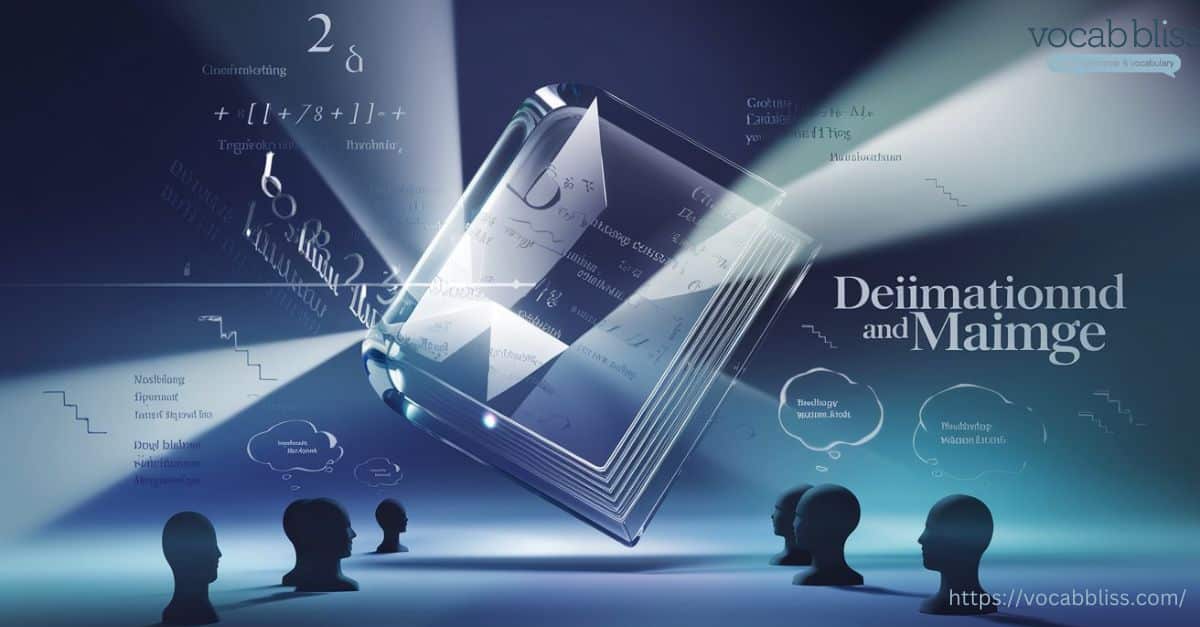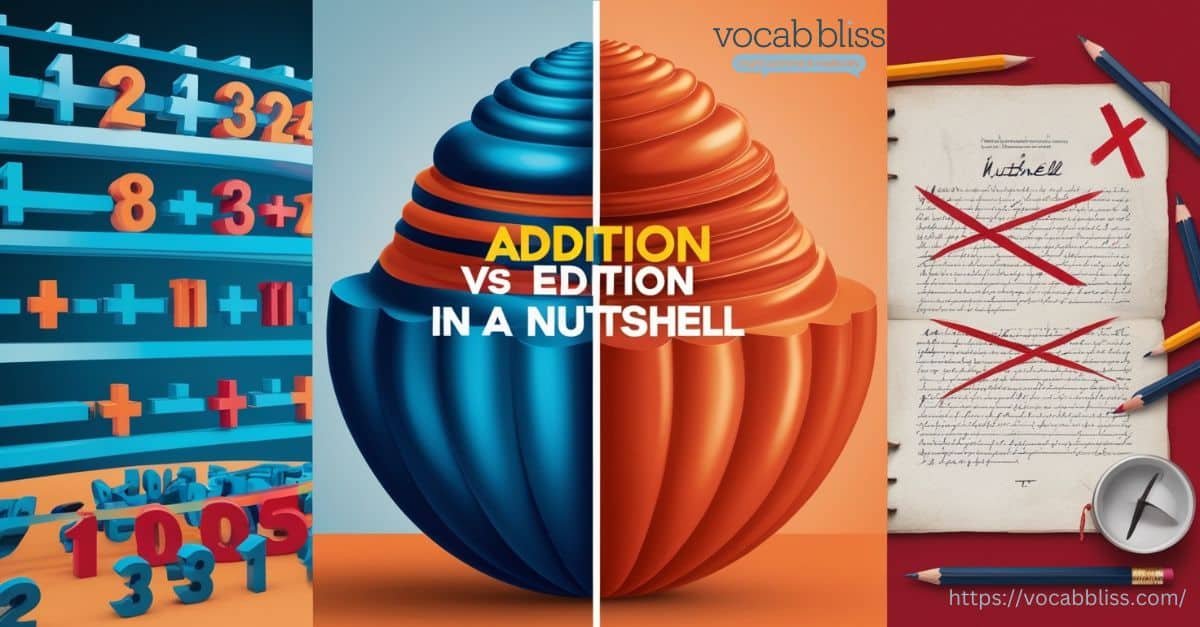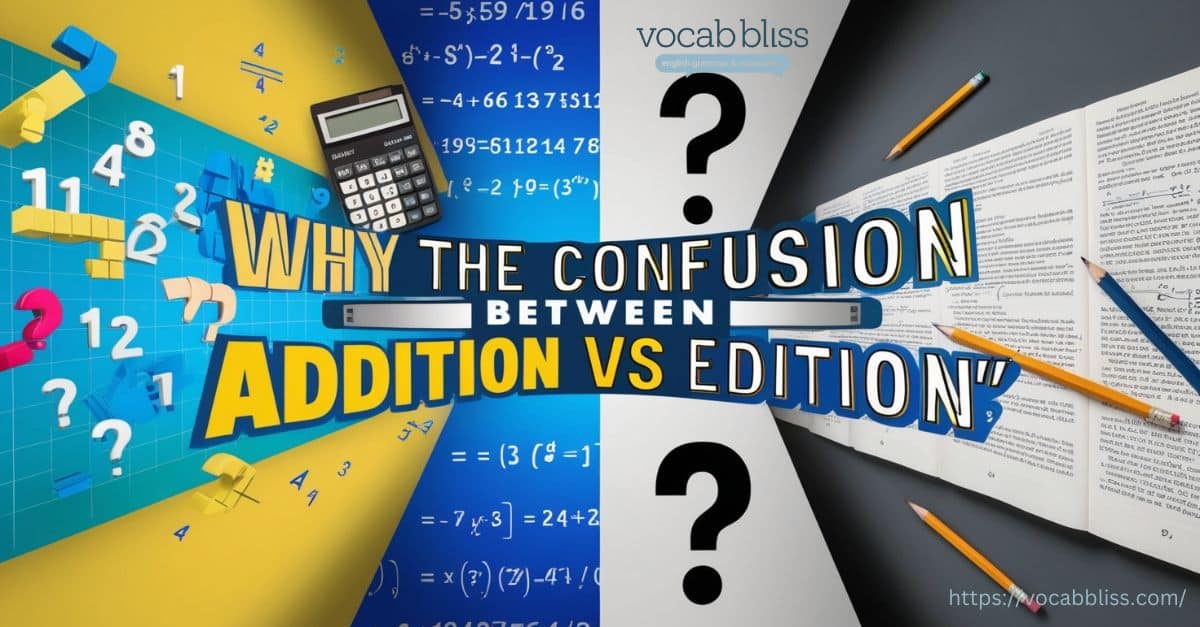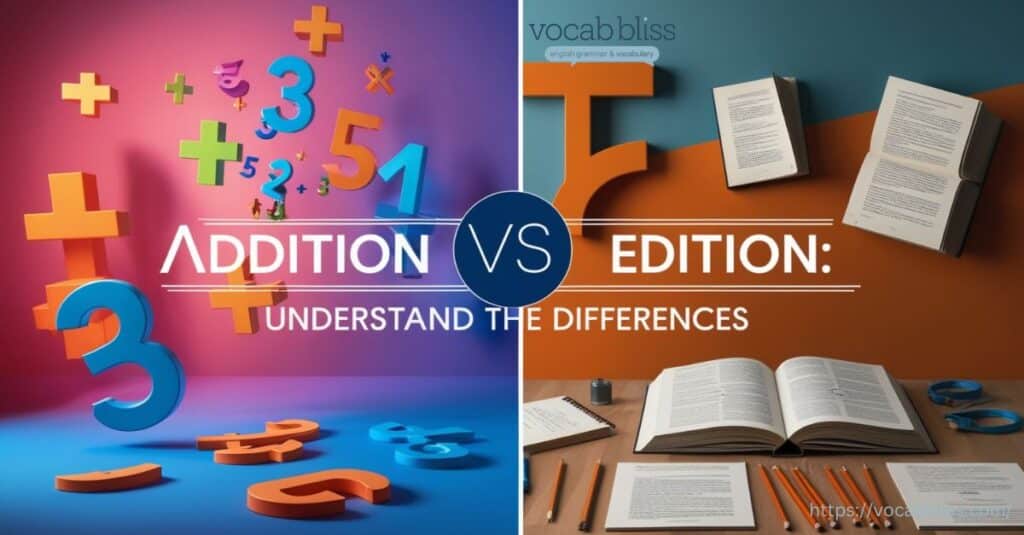When it comes to writing and speaking English, words like addition vs edition can often trip people up. They sound somewhat similar but have vastly different meanings and uses. Misusing these words can lead to confusion, especially in professional and academic contexts. This article provides an in-depth look at the differences between addition and edition, their definitions, examples, and how to use them correctly. Let’s dive in and clear up the confusion once and for all.
Quick Summary
Understanding the difference between addition vs edition is essential to using these terms correctly in both writing and speech. Addition refers to the act of adding or including something, often associated with math, updates, or expansions. On the other hand, edition relates to specific versions or releases, particularly in publishing, media, and collectibles. While their similar pronunciation can cause confusion, remembering that addition involves “adding” and edition ties to “editing” can help. By focusing on their distinct definitions, usages, and contexts, you can avoid mix-ups and communicate more effectively.
What Are Addition vs Edition?
The terms edition vs addition are two distinct words in the English language that often confuse people because of their similar pronunciation and overlapping contexts. While they share some phonetic resemblance, their meanings, applications, and the situations where they’re used are entirely different.
Brief Introduction to the Terms
- Addition: This word refers to the act of adding, increasing, or including something. It’s commonly used in mathematics, architecture, and everyday speech to denote something extra or newly incorporated. For instance, “The addition of new features enhanced the product.”
- Edition: This term signifies a specific version, release, or form of a work, such as a book, magazine, or software. It’s commonly found in publishing and media. For example, “The latest edition of the textbook includes updated research.”
Why These Words Often Confuse People
- Similar Pronunciation: In spoken English, the slight difference between the “add” in addition and “ed” in edition can easily be missed, especially in casual or fast-paced conversations.
- Context-Specific Meanings: Both words are often used in contexts involving creativity, improvements, or enhancements. For instance, a “new addition to a team” and a “new edition of a book” can appear related at first glance, even though their meanings differ significantly.
Understanding “Addition”
Definition and Meaning

The word addition originates from the Latin term additio, meaning “to add.” Over time, it has evolved into a versatile English word used to describe the act of combining, joining, or including something new. Fundamentally, addition is associated with growth, enhancement, or expansion.
In its simplest form, addition refers to the process of increasing something by adding to it. This could apply to numbers, physical objects, ideas, or even concepts in everyday conversations. For example, “The addition of new ingredients improved the dish’s flavor.”
Common Usages of “Addition”
- Mathematics:
- In arithmetic, addition is one of the most fundamental operations, used to combine two or more numbers to form a sum. For example, 4 + 3 = 7.
- It’s foundational for other mathematical disciplines like algebra and calculus.
- Everyday Language:
- Addition is commonly used to describe the act of including something new. For instance:
- “In addition to coffee, she ordered a muffin.”
- “The addition of fresh flowers brightened the room.”
- Addition is commonly used to describe the act of including something new. For instance:
- Business and Design:
- In business contexts, addition might refer to new hires, resources, or product features.
- “The latest addition to our product line has been a hit with customers.”
- In architecture or design, it describes expansions or updates to existing structures.
- “The addition to the house included a spacious sunroom.”
- In business contexts, addition might refer to new hires, resources, or product features.
Examples of “Addition” in Context
Here’s how the word addition is used across various scenarios:
- Mathematics:
- “The addition of fractions requires finding a common denominator.”
- Language:
- “In addition to her skills, she brings enthusiasm to the team.”
- Business:
- “The addition of eco-friendly features to the product increased its market appeal.”
- Construction:
- “They’re planning an addition to the main building to accommodate more offices.”
How to Use “Addition” in a Sentence
To use addition correctly, it’s essential to match its meaning to the context. Here are some tips:
- Match the Context:
- Use addition in math-related contexts to describe numerical increases.
- In general language, employ it to indicate something newly incorporated.
- Pair with Prepositions:
- Prepositions like to and in often follow addition to clarify relationships.
- Correct: “In addition to the main course, dessert was served.”
- Incorrect: “In addition of the main course…”
- Prepositions like to and in often follow addition to clarify relationships.
- Formal and Informal Usage:
- Addition works seamlessly in both formal and informal settings.
- Formal: “The addition of new regulations has improved safety standards.”
- The new addition to the family brought joy and excitement to their lives.
- Informal: “Hey, we’ve got an addition to the team—meet Sarah!”
- Addition works seamlessly in both formal and informal settings.
By mastering the proper usage of addition, you’ll avoid common mistakes and communicate with clarity, whether discussing math, architecture, or casual updates in daily life.
Understanding “Edition”
Definition and Meaning
The word edition comes from the Latin editio, which means “a bringing forth” or “publication.” Initially tied to the act of producing written or printed works, its usage has expanded to encompass various formats and releases. Today, edition refers to a specific version, release, or format of a work, often emphasizing changes, updates, or exclusivity.
In publishing and media, edition is widely used to denote a distinct version of a book, magazine, newspaper, or software. For example, “The second edition of the novel includes additional chapters.”
Common Usages of “Edition”
- Books, Magazines, and Software:
- In literature and journalism, edition specifies versions of a printed or digital work:
- “The first edition of the book became an instant bestseller.”
- “Today’s evening edition of the newspaper features breaking news.”
- Software development uses the term to indicate versions with distinct features or improvements:
- “The premium edition of the app includes advanced tools.”
- In literature and journalism, edition specifies versions of a printed or digital work:
- Limited or Revised Releases in Fashion, Art, and Collectibles:
- The term edition also applies to exclusive or one-time releases in creative industries:
- Fashion: “This is a limited edition handbag available only for a month.”
- Art: “The gallery displayed a special edition print signed by the artist.”
- Collectibles: “The collector’s edition of the game includes bonus items.”
- The term edition also applies to exclusive or one-time releases in creative industries:
Examples of “Edition” in Context
Here’s how edition is used in different scenarios:
- Publishing:
- “The author plans to release an expanded edition of the novel next year.”
- Media:
- “The morning edition of the news program aired live coverage of the event.”
- Fashion:
- “Her limited-edition jacket quickly sold out online.”
- Collectibles:
- “The first edition of this comic book is highly sought after by fans.”
- Technology:
- “The pro edition of the software offers advanced features for professionals.”
How to Use “Edition” in a Sentence
To apply edition correctly, follow these practical tips:
- Understand the Context:
- Use edition when referring to versions of creative or informational works, such as books, software, or collectibles.
- Avoid using it interchangeably with addition, as their meanings differ entirely.
- Pair with Descriptive Adjectives:
- Edition often works alongside adjectives to specify uniqueness or purpose:
- “The updated edition includes a new preface.”
- “A collector’s edition was released for the movie’s anniversary.”
- Edition often works alongside adjectives to specify uniqueness or purpose:
- Professional and Casual Usage:
- In professional settings, use edition formally to refer to product iterations or media releases:
- “This edition of the journal is dedicated to climate change research.”
- Casually, it can highlight exclusivity or rarity:
- “I just bought the limited edition sneakers—they’re amazing!”
- In professional settings, use edition formally to refer to product iterations or media releases:
By using edition with precision and clarity, you can effectively communicate about versions, releases, and exclusivity, ensuring your message resonates in both professional and everyday conversations.
Addition vs Edition in a Nutshell

Although edition or addition may sound alike, their meanings and usages are entirely distinct. Here’s a concise summary of their definitions, key differences, and applications to help clarify how these words differ.
Side-by-Side Summary: Meanings and Key Differences
| Aspect | Addition | Edition |
|---|---|---|
| Definition | The act of adding or including something new. | A specific version, release, or format of a work. |
| Origin | From the Latin additio, meaning “to add.” | From the Latin editio, meaning “a bringing forth” or “release.” |
| Primary Usage | Refers to increase, inclusion, or joining (e.g., math, updates). | Refers to distinct versions or formats (e.g., books, software). |
| Examples | “The addition of new chairs made the room complete.” | “The second edition of the book includes updated research.” |
| Common Phrases | “In addition to,” “new addition,” “a valuable addition.” | “First edition,” “limited edition,” “special edition.” |
Detailed Comparison
Definitions
- Addition: Focuses on the concept of adding something to an existing group or quantity.
- Edition: Focuses on versions or iterations of creative or informational works.
Usages
- Addition:
- Math: Adding numbers to produce a sum.
- Everyday Language: Incorporating or joining something new.
- Business/Design: New features or expansions, like an addition to a building.
- Edition:
- Publishing/Media: Versions of books, magazines, or newspapers (e.g., “special edition”).
- Art/Fashion: Limited or exclusive releases (e.g., “limited edition artwork”).
- Software: Iterations or updates of applications (e.g., “premium edition”).
Examples in Context
- Addition:
- “In addition to his skills, he also brings a strong work ethic to the team.”
- “The addition of a patio transformed their backyard into a beautiful retreat.”
- Edition:
- “The collector’s edition of the video game includes exclusive content.”
- “The second edition of this textbook is now available with updated chapters.”
Comparison Table
Here’s a quick table comparing their common phrases and expressions:
| Phrase | Addition | Edition |
|---|---|---|
| In addition to | “In addition to her qualifications…” | (Not applicable) |
| New addition | “A new addition to the family.” | (Not applicable) |
| First edition | (Not applicable) | “The first edition of the book…” |
| Limited edition | (Not applicable) | “This is a limited edition product.” |
| Special edition | (Not applicable) | “A special edition magazine release.” |
Why the Confusion Between “Addition vs Edition”?

The confusion between addition or edition is common, and it’s easy to see why. These words share a similar pronunciation, especially in certain accents, and their meanings sometimes overlap in specific contexts. Let’s break down why these mix-ups happen and how to avoid them.
Similar Sounds: Are They Homophones?
- In Some Accents:
Depending on the speaker’s accent or dialect, addition and edition can sound nearly identical. For example, in some American English and British English accents, the subtle difference in the initial vowel sounds (a vs. e) may not be pronounced distinctly.- Addition: /əˈdɪʃən/
- Edition: /ɪˈdɪʃən/
- Misheard Words:
Overlapping sounds can lead to miscommunication. For instance, hearing “a new edition” might be mistaken for “a new addition” if the context isn’t clear.
Contexts Where People Mix Them Up
- Publishing vs. Expanding
- When discussing updates or changes, people may confuse addition (introducing something new) with edition (a revised version).
- Example:
- Incorrect: “This book has a second addition.”
- Correct: “This book has a second edition.”
- Everyday Speech
- In casual conversations, listeners might not immediately distinguish the subtle differences in pronunciation.
- Writing Errors
- Typographical errors often cause confusion, especially when both words seem plausible. For instance, “A new addition to the magazine” might mistakenly appear as “A new edition to the magazine.”
Simple Tricks to Remember the Difference
Here are some easy ways to ensure you don’t mix up housing addition or edition:
- Think About Context
- If it’s about adding something, use addition (e.g., math, joining, or including).
- If it’s about a version, use edition (e.g., books, media, or products).
- Mnemonic Devices
- Addition has an “A” for adding something new.
- Edition has an “E” for editing or revising a work.
- Word Associations
- Pair addition with math, inclusion, or extra items.
- Pair edition with books, releases, or special versions.
- Practice with Examples
- Write sentences using both words in clear, distinct contexts:
- Addition: “The addition of a new member improved the team’s performance.”
- Edition: “The first edition of the novel became a classic.”
- Write sentences using both words in clear, distinct contexts:
A Quick Visual Reminder
| Key Aspect | Addition | Edition |
|---|---|---|
| Meaning | Adding something new | A version or release of a work |
| Mnemonic | “A” for adding | “E” for editing |
| Common Context | Math, updates, or inclusion | Books, media, or exclusivity |
| Example Phrase | “In addition to this feature…” | “The second edition is better.” |
Side-by-Side Comparison Table
| Aspect | Addition | Edition |
|---|---|---|
| Definition | Adding something | Version or release |
| Context | Math, general inclusion | Media, publishing |
| Examples | “Addition of a new wing.” | “First edition of the book.” |
| Pronunciation | Stress on “add” | Stress on “ed” |
FAQs “Addition vs Edition”
What is the difference between edition and addition?
Addition refers to adding something, while edition refers to a version of something. For example, “the addition of a chapter” versus “the second edition of the book.”
When should you use new edition versus new addition?
Use new edition for updated versions (e.g., “new edition of a software”). Use new addition for something added (e.g., “new addition to the team”).
Is it limited addition or limited edition?
It’s limited edition. This phrase is used to describe exclusive or rare versions of products.
What is an edition?
An edition is a particular form or version of a published work, such as a book, magazine, or software.
How do you use edition and addition in sentences?
- Edition: “The second edition of the novel was a bestseller.”
- Addition: “The addition of more resources improved the project’s outcome.”
Conclusion
Mastering the differences between addition vs edition is essential for clear communication. While addition involves including or adding, edition refers to specific versions or releases. By understanding their unique definitions, contexts, and examples, you’ll confidently use these terms without confusion.
Now that you’ve explored this detailed guide, try using these words in your writing and speech. As they say, practice makes perfect!
Continue reading:
- How Do You Spell Christmas, Christmases, or Christmas’s?
- Analogy vs Allegory: What’s the Difference?
- is it Latter or Ladder: How to Use?
- Concave vs Convex: What’s the Difference?
- Forward vs Forwards: What is the difference

Jorge Phillips is an experienced blogger who writes for Vocab Bliss, sharing his passion for the English language. With a knack for simplifying complex grammar rules and a focus on commonly confused words, Jorge helps readers navigate the nuances of English with ease. His insights aim to make learning engaging and practical.







